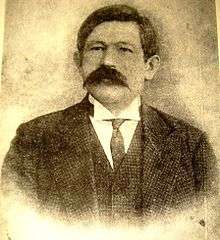Ayaz İshaki
Ğayaz İsxaqıy aka Ayaz İshaki (Tatar: Cyrillic Гаяз Исхакый, Latin Ğayaz İsxaqí, Russian: Гаяз Исхаки, Gajaz Ishaki) (10 February 1878 — 22 July 1954) was a leading figure of the Tatar national movement, author, journalist, publisher and politician.[1]

Biography
Gayaz Ishaki was born in 1878 in the village of Yaushirma near Kazan to a Mishar Tatar family. He was home-schooled by his father at an early age and was sent to study in a madrasah (religious school). He continued his education in the Russian-Tatar teachers' school (1898–1902).
Gayaz Ishaki moved to Kazan in 1904, where he became acquainted to socialists and adopted some of their views. He became involved in revolutionary activities, participated in all-Muslim congress in 1905[2] and subsequently was arrested and sent to a prison near the city of Arkhangelsk in northern Russia in 1907.
After the February revolution of 1917 he was involved in activities aimed at achieving cultural autonomy for the Volga Tatars and other Turkic peoples of Russia. As a result of his activities, the Soviet authorities started a campaign of harassment and persecution against him and his associates. He was forced to emigrate in 1920. After settling in Germany, Gayaz Iskhaki started publishing a Tatar-language magazine "Milli Yul" ("The Way of the Nation") in 1928.[3] In 1931 he presided over the Independence Committee of the Muslims in Idel Ural.[2]
In 1939 the magazine was closed and Iskhaki decided to immigrate to Turkey. After World War II he became involved in political activities. At this stage his main goal was the restoration of the Tatar nationhood lost in 1552 when the Kazan Khanate was defeated and occupied by the Moscow Principality.
Throughout his life Gayaz Iskhaki traveled to Poland, Germany, Japan, China and Turkey where he tried to establish Tatar-language press and unite disparate Tatar emigree communities.
Gayaz Iskhaki died in 1954 and was buried in Edirnekapı graveyard of Istanbul.
Bibliography
- İsxaqıy, Ğayaz. Äsärlär unbiş tomda. Edited by M. Kh. (Mansur Khasanovich) Khasanov. Kazan: Tatarstan kitap näşriäte, 1998.
- Kamaliyeva, Alsu. Romantik Milliyetçi Ayaz İshakî. Ankara: Yayınları, 2009.
- Muhammed Ayaz İshaki: Hayatı Ve Faaliyeti, 100. Doğum Yılı Dolayısıyla. Ankara: Ayyıldız Matbaası, 1979.
- Säxapov, Äxmät. Ğayaz İsxaqıy : načalny etap tvorčestva : monografija. Kazań: Master Line, 2003.
- ———. İshaki i tatarskaja literatura XX veka. Kazań: PIK Dom Piečati, 2003.
- Ахунов, Азат М. “Гаяз Исхаки «Кто он? Кто он, кто нашу нацию взрастил?»." Татарский мир, 2004, №3. https://web.archive.org/web/20180322003928/http://www.tatworld.ru/article.shtml?article=489§ion=0&heading=0.
- Сахапов, Минахмет Ж. Золотая эпоха татарского ренессанса. Казань: Таткнигиздат, 2004.
References
- Сахапов, Минахмет Ж (2004). Золотая эпоха татарского ренессанса. Казань: Таткнигиздат. ISBN 5-298-04063-2.
- Landau, Jacob M. (1981). Pan-Turkism in Turkey. London: C. Hurst & Company. p. 81. ISBN 0905838572.
- Von Sonnennschirmen und Wilden Horden (in German). LIT Verlag Münster. p. 87. ISSN 1434-0542.